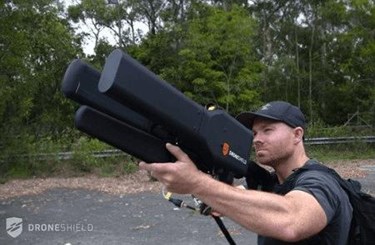Radio Wave Gun Disables Drones From A Mile Away
By Jof Enriquez,
Follow me on Twitter @jofenriq

A rifle-like signal jammer that can disable an unmanned aerial vehicle (UAV) from 1.2 miles (2 kilometers) away is the latest technology developed to neutralize threats posed by drones deployed for nefarious purposes.
Several types of drones are readily available commercially, and these flying machines, in the wrong hands, could pose a threat to government facilities, commercial jets, power plants, industrial facilities, and private property. Drug cartels and smugglers already are using drones to deliver contraband, and terrorists are using shop-brought drones to inflict damage on enemy troops and civilians. The escalating threat scenarios have produced a concomitant rise in anti-drone technologies.
One company developing such technologies, Sydney and Virginia-based DroneShield, recently introduced its DroneGun, which works by jamming the radio frequency signal in a drone to wrest control away from its remote pilot, and to land the drone safely on the ground away from its target area.
The 13-lb (6-kg) radio wave gun operates over two common signal frequencies (2.4 and 5.8 GHz), and fires jamming signals via a lightweight battery backpack carried by a single person more than a mile away. It also blocks the drone's video and global positioning satellite (GPS) transmission, so that the drone's built-in safety feature of automatic landing is triggered after being disabled, preventing the original operator to regain control.
"Most modern drones are equipped with a protocol that they come back to their operator when the radio frequency signal is jammed, and land when radio frequency and GPS are both jammed," company spokesman Mr. Oleg Vornik told Mail Online. "The jammer doesn’t control the drone, it's an automatic response from the drones themselves."
The DroneGun technology "allows for a controlled management of drone payload such as explosives without damaging common models or the surrounding environment," adds Vornik.
DroneShield CEO Peter James told PC Authority that the target market for the gun includes “a wide range of customers from government and military agencies to civil infrastructure to VIP protection.”
Escalating threats posed by UAVs have forced authorities, companies, and engineers to develop their own anti-drone technologies. While the Dutch police have decided on using eagles to take out errant drones, others are employing more technologically-advanced solutions.
For example, a trio of British companies have developed the gun-like Anti-UAV Defence System (AUDS) capable of detecting a drone five miles (8 km) away using electronic scanning radar, tracking it using infrared and daylight cameras and specialist software, and then disrupting the flight using an inhibitor to block the radio signals that control it.
Researchers at Michigan Tech University's Human-Interactive Robotics Lab have unveiled a new method of capturing rogue drones in mid-flight, one of several net-deploying anti-drone solutions in development.
The Defense Advanced Research Projects Agency (DARPA) is currently reviewing conceptual designs and technologies to defend U.S. forces against drones. It recently launched its Aerial Dragnet program to seek innovative technologies to provide persistent, wide-area surveillance of unmanned aerial systems (UAS) operating below 1,000 feet in a large city to protect urban-deployed troops and civilians from terror attacks.
